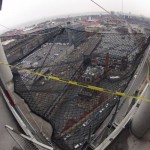Debris Netting Fall Protection: When To Rent Versus When To Purchase
 When it comes to fall protection systems, safety netting provides some of the best protection for workers on high rise construction or demolition projects. Personnel cantilever systems can be installed around the exteriors of high rise buildings. The safety netting is hung from outrigger poles, which are attached around the perimeter of a certain floor, to catch workers if they fall. (This type of system can also be installed on the sides of bridges to ensure worker safety.)
When it comes to fall protection systems, safety netting provides some of the best protection for workers on high rise construction or demolition projects. Personnel cantilever systems can be installed around the exteriors of high rise buildings. The safety netting is hung from outrigger poles, which are attached around the perimeter of a certain floor, to catch workers if they fall. (This type of system can also be installed on the sides of bridges to ensure worker safety.)
Also, same-floor netting can be installed in the interiors of buildings under construction. Heavy duty industrial nets are stretched over the spaces between beams, to ensure worker safety and provide a working surface, until the concrete is poured or the floor is laid down.
(In either case, personnel safety netting can also serve to catch debris before it falls to the ground below. A fine-mesh liner can be placed inside the stronger weave to catch falling objects such as screwdrivers, nails, or screws that might otherwise slip through the mesh. Debris netting is also useful in demolition projects to catch building fragments as they fall.)
Many construction companies wonder if it’s better to buy or rent the equipment. It depends on several factors, including the types of construction/demolition projects you do, the locations where you do them, how often you do them, and how similar one project is to the next.
Buying Fall Protection and Debris Netting
If your business is a nationwide construction firm that handles high-rise jobs in multiple cities and states (i.e. New York, Pennsylvania, and New Jersey), you might want to think about investing in your own fall protection netting system. If a high-rise project is going to last six months or more, or if your firm routinely handles several high-rise projects in one city or state throughout the year, it may be more cost effective to buy the equipment.
Purchasing a horizontal perimeter or same-floor system allows you to use it on multiple projects, and to have it ready for future projects. If you buy the netting system, you usually get a Return On Investment in six to eight months. But there are several things to consider when you buy this type of construction netting.
First, you have to consider how you will use it on each high-rise project you do. When you purchase, make sure the company you buy it from offers installation training. Usually, the company will send a trainer to a high-rise job site and spend a day or more training your employees on how to properly install the nets and related hardware outside or inside a building. You will save yourself considerable money if your workers can install the system themselves, instead of having the company you bought it from install it for you at every high-rise job site.
You also have to maintain the material once you purchase it. With each job, you have to inspect the nets (both before deployment and periodically during the time it is in use) to make sure they are in good working order. If the nets or any of the other equipment is damaged, you need to have it repaired or replaced. Depending on how much you use it, you should plan to buy new netting and equipment every few years.
Fall Protection Netting Rental
Rental might be your best option if you plan to use safety netting only for a single construction project, and only for a limited time (i.e. 6 months). If, for example, your company handles mostly retail or housing construction, and you only get a high-rise project once every couple of years, it may not be worth the expense to buy. You may save money by renting it.
There are other reasons for renting. Sometimes it’s necessary not just to comply with OSHA fall protection requirements, but with city and state regulations. For example, New York City has building codes that require personnel and debris netting systems for any building project over six stories.
You may be working an out-of-state construction project where you wouldn’t normally be required to have fall protection netting. But a local building inspector may insist that you have personnel or debris netting for the job, to achieve OSHA compliance with state regulations. In that case, it’s better to rent it for that one project.
Even if you’ve already purchased a fall protection netting system, you may need to rent it on occasion. Not every building project is the same, and sometimes the equipment you have can’t be adapted to the dimensions of the building.
For example, let’s say you own a horizontal perimeter system where the outrigger poles have “slab-grabbers” that can be attached to floors with a thickness of up to 18 inches. This is usually no problem, since you normally handle high-rise renovation projects on buildings with a floor thickness of 12 inches.
But then you get a high-rise renovation project where the floors are 30 inches thick. The “slab grabbers” on your outrigger poles won’t attach to these floors. In this case, it’s better to rent netting equipment that fits the specifications of the project rather than buy just for this one job.
Buying Custom Netting Solutions
One more type of industrial netting system needs to be quickly mentioned. In our previous blog article, we talked about safety netting solutions for overhead conveyor belts. These types of custom solutions are usually installed as permanent solutions, in which case you would want to buy.

